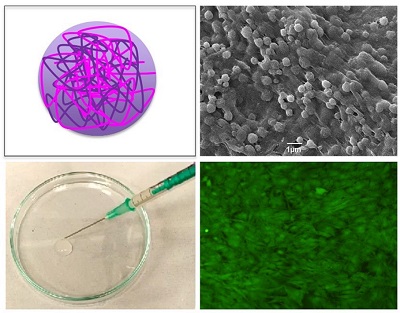Injectable Self-Assembled Microgels Enhance Stem Cell Growth
A new technology developed in the Department of Chemistry can fabricate injectable biocompatible microgels, with sub-micrometre diameters, that can release bioactive agents and hence enhance stem cell growth.
Self-assembled gels have great potential for wide-ranging applications including drug delivery and tissue engineering. These versatile materials spontaneously and reversibly assemble from small-molecule building blocks. However, the gels are often very weak, and this can make it difficult to fabricate them with controlled shapes and sizes. In particular, it is very challenging to make microgels with sub-micrometre particle sizes. Such microgels would have applications in biomedicine because their small size potentially allows them to be injected, meaning they could play a role in tissue repair or drug delivery.
In a major breakthrough, Dr Carmen Piras, working in the research team of Professor David Smith developed a new way of stabilising sub-micrometre self-assembled gel particles. She developed a way of making gel beads that were just 800 nanometres (0.8 micrometres) in diameter, and then stabilised them in a simple process using alginic acid, a naturally-occurring polymer found in seaweed, as a reinforcing agent.
Dr Piras demonstrated that these microbeads were stable to the injection process, were stable in cell culture medium and could be loaded with heparin, a bioactive agent. In collaboration with Dr Alasdair Kay and Professor Paul Genever in the Department of Biology, she then went on to demonstrate that her microgel beads could release heparin, encouraging enhanced stem cell growth.

Schematic of microgel (top left), electron microscopy image showing particles smaller than 1 micrometre (top right), injection of the microgel through a syringe (bottom left), stem cell growth encouraged by heparin-releasing microgels (bottom right).
As Carmen explains: “Injectable systems that can release heparin and assist stem cell growth are of great potential interest in tissue regeneration. Stem cells are being explored to encourage recovery after tissue damage or major surgery. A simple, injectable, biocompatible microgel that can encourage greater stem cell proliferation in the damaged area would be of great potential value.”
Reflecting more broadly on the research, Professor Smith said: “This approach to self-assembled microgels should be applicable to very many other self-assembling gels, each of which can have different types of activity and potential uses. This innovative fabrication method should therefore open up a wide range of applications that were simply not previously possible.”
The work was funded by EPSRC and is published in Chemical Science, the flagship open access journal of The Royal Society of Chemistry.